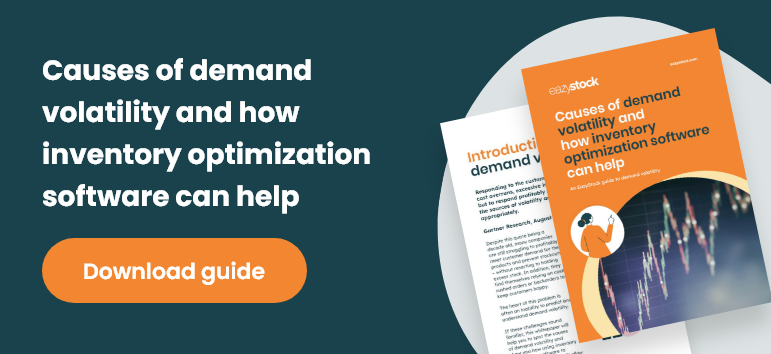Data-driven inventory management: the secret to business success
In the rapidly evolving business landscape, staying ahead of the competition requires more than just good instincts – it demands data-driven decision making. When it comes to inventory management, relying on gut feelings and historical data may lead to inefficiencies, missed opportunities and incorrect inventory levels. When combined with manual inventory management processes, you increase the risk of human errors, which can culminate in stockouts and overstocking.
Don’t worry! In this blog, we’ll explore the untapped potential of data-driven inventory management.
The downside of manual processes
Picture this: spreadsheets upon spreadsheets, outdated inventory records, and a constant struggle to stay on top of stock levels. If that’s your reality, you’ll identify with the leading precision engineering cutting tool distributor, Cutwel. Like many businesses, they were grappling with manual inventory processes, which they knew weren’t sustainable. Fortunately, their journey to success took a significant turn when they embraced a data-driven approach.
The game-changer: Intelligent inventory solutions
Enter the game-changer – cutting-edge data-led inventory management system, EazyStock. By harnessing the power of data, EazyStock’s advanced functionality enables businesses to make smarter decisions, anticipate demand, and optimize stock levels, enhancing efficiency and profitability.
As a cloud-based inventory optimization solution, EazyStock connects to your enterprise resource planning (ERP) or existing business system. It then automates those time-consuming and inaccurate manual inventory management processes.

Empowering your business with data
Data-driven inventory management includes:
- Data collection: Rather than collating information from various spreadsheets, using software like EazyStock enables you to automate information gathering from multiple sources, such as sales records, demand patterns and trends, supplier lead times, and production schedules, and hold them in one place.
- Data analysis: Software’s powerful algorithms and complex calculations make it easy to analyze data to identify trends, patterns, and correlations. You’ll be able to calculate the optimal reorder points and set the right safety stock levels to meet any variance in demand and lead times.
- Accurate demand forecasting: One of the standout benefits of data-driven inventory management is its ability to make precise demand forecasts. Historical purchasing data, coupled with real-time sales insights, helps businesses predict future demand with greater accuracy. Say goodbye to overstocking and stockouts, as data guides your inventory levels.
- Optimal inventory levels: Your team might know your products inside out, but wouldn’t it be great if you had the data to back up their gut feelings? Instead of relying on guesswork to determine the right inventory levels, data-centric solutions analyze variables including lead times and sales trends. This ensures your inventory stays optimized and in the sweet spot – neither holding excess stock nor running out of critical items.
- ABC analysis: If you treat all your SKUs the same when it comes to inventory management, you likely have a mix of understocked and overstocked items. EazyStock can differentiate and prioritize items into categories (ABC) according to profitability and demand. Automating inventory analysis allows you to carry out multi-dimensional item categorization including more variables. EazyStock then recommends inventory policies and provides service level targets and safety stock levels down to SKU levels. Automation also means calculations can be updated daily, with alerts for when products switch categories, so segmentations align with market dynamics.
- Economic order quantity (EOQ): The EOQ balances holding costs or carrying costs with ordering costs to find the point where both are minimized and match. Manually calculating the EOQ is time-consuming and prone to errors in replenishment. Using inventory optimization software removes the pain of the calculation and overcomes the limitation of the EOQ model.
- Enhanced resource allocation: Efficient resource allocation is a cornerstone of business success. With data-driven inventory management, you can allocate resources more effectively, optimizing storage space, reducing carrying costs, and maximizing your team’s productivity.
- Real-time visibility: Bid farewell to the days of navigating through a labyrinth of spreadsheets. Data-led solutions offer real-time inventory visibility, empowering you to make timely decisions and swiftly respond to market changes.
Conclusion
Cutwel’s success story is a powerful testament to the transformative potential of data-driven inventory management. By adopting a data-fueled solution like EazyStock, you can harness the full power of data to optimize inventory levels, make accurate forecasts, reduce stockouts and enhance resource allocation.
With real-time inventory visibility, you can say goodbye to the days of manual processes and guesswork and make informed decisions that drive efficiency and profitability. Data-driven inventory management ensures you stay ahead of the competition, reduce carrying costs, improve cash flow and enhance customer experience through improved on-shelf availability.
If you’d like to know more about how EazyStock can help transform your inventory management, please get in touch.








